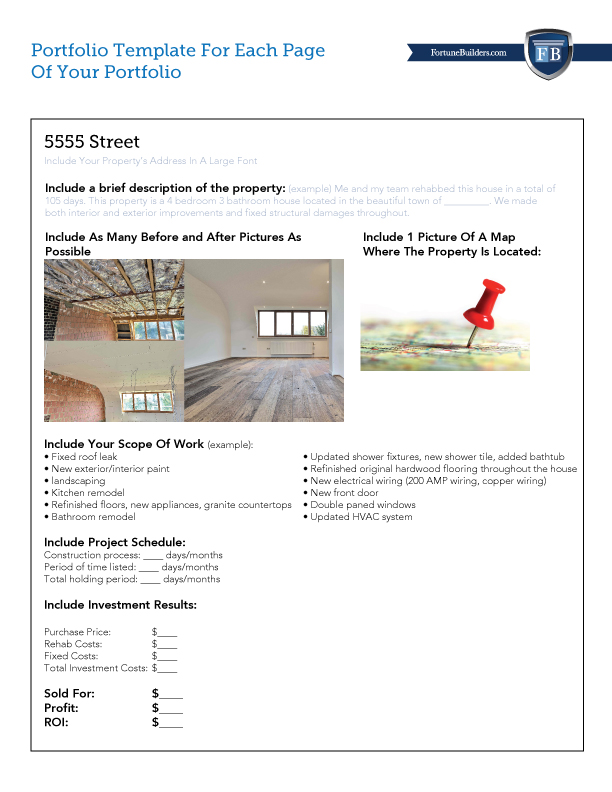Key Takeaways
With the real estate portfolio template below, investors of all levels should be able to compile their assets in a way that is invaluable to their future performance. If for nothing else, a proper portfolio will serve as an essential tool in building out your career. Much more than a cosmetic gimmick, a real estate portfolio is essentially your resume to provide others with if you hope to do business together in the future. That said, an investment portfolio is not to be taken lightly; it must represent a strong display of your own experience. How else will people know if they want to work with you?
What Is An Investment Portfolio Template?
Make no mistake about it: a real estate portfolio is essential to your success as an investor. It’s the one tool that can put your talents on display and convince those in the industry that you are indeed a worthy person to go into business with. And since it is so important, there is no reason to leave anything up to chance. I maintain that you should use a real estate portfolio template when making your own asset collection. That way, you know your presentation will shine through.
One of the greatest assets a real estate investor can own is a well-maintained real estate portfolio. It will not only act as an anthology of past and present real estate transactions but serve as your marketing arsenal when it comes to finding and acquiring funding for potential deals. In essence, a real estate portfolio is a compilation of different investment assets based on factors like your risk tolerance, time horizon, and objective for the primary purpose of achieving your goal. (Key for a first time real estate investor.)
If you are unfamiliar with the thought, as your real estate mentor or another trusted connection in the industry for a real estate portfolio example. It may help to see what completed deals look like in a portfolio setting as you build yours — but remember, every portfolio will be slightly different. Yours should showcase your unique standing and experience.
Along with showcasing your personal investment goals and strategies, a real estate investment portfolio will reveal the inner workings of deals you’ve completed and currently own. For those unfamiliar, a real estate portfolio template will include your main objective, a breakdown of the numbers pertaining to your real estate transactions, asset allocation, and management. That said, the importance of your real estate portfolio as a residential redeveloper is vital. Not only is it essential to growing long-term wealth, but it is a critical component to obtaining financing for future projects.
[ Thinking about investing in real estate? Register to attend a FREE online real estate class and learn how to get started investing in real estate. ]

How To Build An Investment Portfolio
Creating a strong investment portfolio is crucial to your success as a real estate investor. Although, there is more to it than simply showcasing your existing deals. Investors eager to build their investment portfolios need to understand the real estate industry and be prepared to seek out new deals. Here are just a few tips for building your investment portfolio:
-
Start Small: As you seek out new properties to invest in, don’t be concerned if you think the property type or deal is “too small” for your investment portfolio (so long as it aligns with your interests). It is important to remember that every investor has to start somewhere, and even if your deals seem small now, they will likely not remain that way forever.
-
Create A Strong Deal Analyzer: One of the most important aspects of real estate investing is being able to identify a good deal and walk away from a bad one. Rely on a strong analyzer, and don’t be afraid to ask questions when considering a given property. To get started, be sure to check out these calculations every real estate investor should know.
-
Add To Your Portfolio As You Go: Don’t wait until the night before a networking event or pitch meeting to add your latest deals to your portfolio. Instead, track your progress as you go along and make sure you are always prepared for potential opportunities.
-
Understand The Financing Available: When identifying new deals, it is important to make sure you are aware of the variety of financing options available to you. Do not let a lack of funding get in the way of building your real estate portfolio. Many financing options are available for your next deal, some of which you may not even be familiar with. Check out this article on real estate financing to learn more.
How Do I Grow My Investment Portfolio?
Building an investment portfolio from scratch is one thing, but maintaining and growing one is entirely different. Both steps are required to get things up and running, but the latter will see that the eventual growth may be maintained. If growing and maintaining a real estate portfolio sounds like something you would like to do, try following these steps:
-
Conduct The Appropriate Research: It is almost impossible to gain ground on any real estate project without conducting the appropriate research, let alone a long-term rental portfolio. To that end, the best way to prepare a portfolio for growth is to develop an intimate knowledge of the local market. Therefore, you’ll want to make sure you know everything about the area and the home. Are there any clues to suggest what the area may be like years down the road? If so, consider them immediately.
-
Establish Clear Objectives: In setting clear objective for your portfolio, you will have a barometer by which you may gauge your progress. Therefore, be sure to set obtainable objectives; that way, you’ll feel a sense of progression and be more inclined to continue moving forward. That, and you’ll actually be able to tell you are making progress.
- Familiarize Yourself With Available Financing Options: Several different financing options are made available to today’s investors, but they are not all created equal; some are inherently better for rental strategies than others. Investors need to carefully consider each option they have and only choose what best suits their previously mentioned goals.
-
Secure Properties Below Market Value: One of the best ways to generate returns on a rental property is to create profit margins on the purchasing end of things. That said, it’s in every investor’s best interest to look for homes that can be acquired under market value.
To do so, look for the most motivated sellers. Whether they are in foreclosure or about to be, motivated sellers are more inclined to sell the home for a discount and in a short period of time, nonetheless. -
Consider Starting With A Multi-Unit Property: A great strategy for building a rental portfolio is to first look for a multi-unit home, like a duplex. The overhead costs are considerably less, and so is the risk of a vacancy. If one tenant doesn’t pan out, another unit’s existence should mitigate the risk associated with unfilled units.
-
Hire A Property Manager: Last, but certainly not least, is the assistance of a third-party property manager. A third-party manager, for that matter, is the single most important piece of the puzzle. It is with their help that rental property portfolio owners can add more assets to their portfolio without adding additional work.
[ Thinking about investing in real estate? Register to attend a FREE online real estate class and learn how to get started investing in real estate. ]
How To Measure Your Portfolio’s Success
A real estate portfolio is not something you can create once and put away. It’s important to update your work and monitor your success consistently. As mentioned above, your portfolio should include a few key numbers from every property and then figures that cover your entire portfolio. These should include your overall net cash flow, annual returns, property appreciation, and vacancy rates to name a few. As you begin to track these numbers, you can add comparisons after six months or annually to show improvement. Comparing your calculations is a great way to measure your success and wow potential lenders.
Another way to measure your portfolio success is to work with a professional portfolio manager. This is a great way to take some responsibility off your plate, giving you more time to focus on finding deals. There are different types of portfolio managers, and their level of involvement will vary depending on the firm you work with. That being said, portfolio managers can track the success of your investments and report on these numbers over time. They will also be able to provide precise recommendations for improvement, which in many cases can help you strengthen your overall performance.
Diversifying A Real Estate Portfolio
A diverse portfolio includes a variety of different asset types and can help hedge a portfolio against certain market risks. If real estate is such a stable investment, you may be asking do I still need to diversify? While real estate is a historically well-performing asset a diversified portfolio can help you accomplish a number of investment goals. Jasen Edwards, Chair of the Agent Editorial Board states that “the primary purpose of the portfolio is to give the investor an overview of his assets. With that, he can determine the loopholes and allow him to create strategies that will create better results for a positive ROI”. Many investors utilize their earnings in real estate to buy stocks, bonds, or other asset types.
Similarly, many real estate investors opt to diversify within the industry. For example, if you operate a rental property you may decide to diversify with a raw land investment or commercial property. Many real estate investors also find success investing in REITs, which provide similar benefits without the same level of involvement. The best route when deciding to diversify is often to seek out a financial advisor who can review your existing portfolio and provide specialized advice. While it is generally recommended to diversify, every situation is different.
Downloadable Real Estate Portfolio Example
It is not uncommon to feel challenged when putting together your first real estate investment portfolio. Showcasing your best work can involve a lot of pressure; however, it is important to know you can adjust your portfolio at any time. As you gain experience in the real estate industry, you will likely get a better idea of how you want to set up your portfolio and make changes. Although not every investment portfolio will look the same, the following real estate portfolio example serves as the perfect template for investors to get started:
Click here for our downloadable template to start building your real estate portfolio today.
Summary
Have you ever wanted to build a real estate portfolio, but weren’t sure where to start? Perhaps you have a template, but it doesn’t represent your best deals? Whatever the case may be, our real estate portfolio template can help you showcase your investment history today. With the right investment portfolio, you can be well on your way to securing your next deal.
Ready to start taking advantage of the current opportunities in the real estate market?
Click the banner below to take a 90-minute online training class and get started learning how to invest in today’s real estate market!
The information presented is not intended to be used as the sole basis of any investment decisions, nor should it be construed as advice designed to meet the investment needs of any particular investor. Nothing provided shall constitute financial, tax, legal, or accounting advice or individually tailored investment advice. This information is for educational purposes only.


